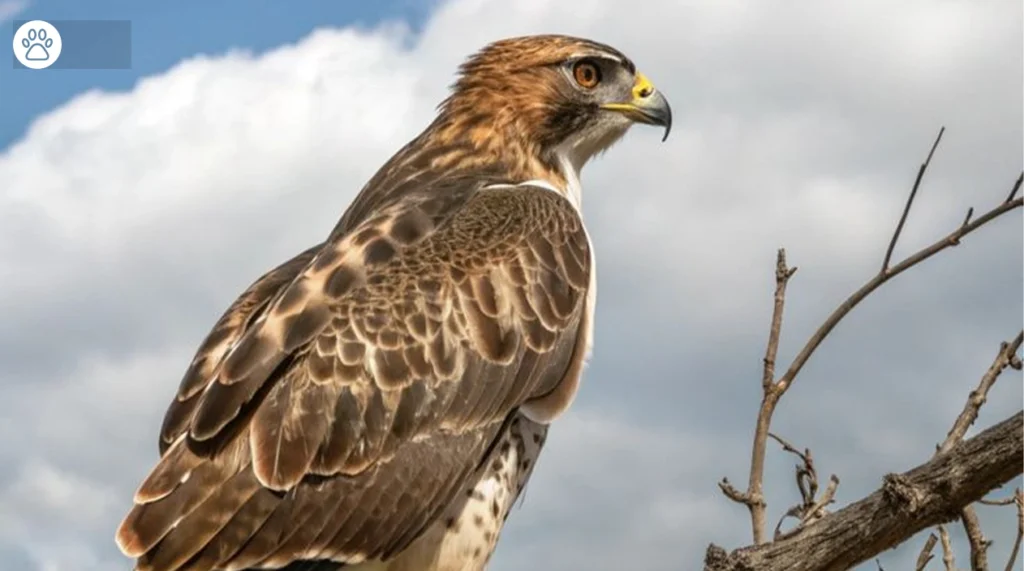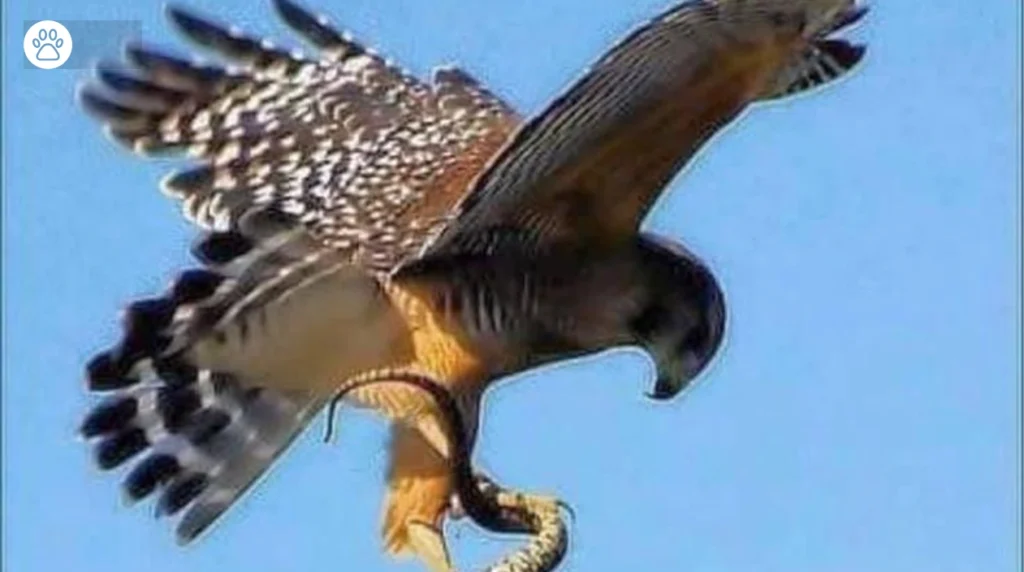The red-tailed hawk is one of the most universal and recognizable types of birds of prey found commonly throughout North America. It is a magnificent bird of prey by every definition. The red-tailed hawk has a powerful build. Their rusty red tail feathers, beautiful contours, and wings make them a fascinating subject for watching birds, seeing them soar over open fields, land on tall poles, and fly above isolated forests. Understanding red-tailed hawks includes a closer understanding of their diet, calls, and interesting facts about their life.
Key Facts About Red-Tailed Hawks
Over and above the diet and calls, red-tailed hawks have many other interesting behaviors and characteristics.
Discover: Red Shouldered Hawk: How to Identify It and Fascinating Feather Facts
Hunting Techniques
1- Perch Hunting: The perch is the most common method of hunting. A red-tailed hawk will perch on tall high ground – a branch of a tall tree, a telephone pole, or the edge of a cliff, waiting patiently and scanning the ground below with amazing sharp eyesight. Once it picks up an object of interest, it dives with tremendous speed.
2- Soaring and Coursing: I have even seen them engage in “coursing” behavior, flying low over fields to flush out prey.
3- Cooperative Hunting: Sometimes, they will hunt together as up to twoSometimes red-tailed hawks hunt on the wing, soaring in large circles high over open areas. They use thermal updrafts to help sustain energy and can sometimes pick out prey from especially great distances. hawks, but this is not common. In cooperative hunting, one hawk will flush prey in the direction of the other hawk.

Reproductive/Nesting
Monogamous: Red-tailed hawks are generally monogamous and often mate for life, returning to the same nesting area and possibly the same nesting territory every year.
Nest site: The nests consist of many sticks, twigs, and branches, and are frequently located in high places in trees or cliff ledges.
Laying eggs: A female lays 1 to 3 (at most 5) eggs, with the male helping to find food for the mother until the eggs are hatched.
Hatching: It takes about 28 to 35 days for the eggs to hatch. When they are young, “eyasses” appear in feathers that are all white due to the down. The young can fly at around 42 – 46 days, yet they continue to rely on their parents for hunting lessons for some time afterward.
Lifespan
Wild red-tailed hawks typically live for 10 -15 years, though a few rare ones have survived well beyond 20 years.
Conservation Status
According to the IUCN Red List, the red-tailed hawk is in good condition and its numbers are stable. Even so, just like all wild animals, they can lose their lives because of habitat changes, the use of pesticides, and being hurt by vehicles or power lines.
Explore Birds Behaviour & Training Category.
Physical Features of Red-Tailed Hawk
Red-tailed hawks are a very common and cosmopolitan bird. It does well in every kind of habitat, from dense forests to wide-open deserts and even in highly urbanized places. Its broad wings and short, broad tail are perfectly suited for soaring, which it does when it’s in the area, searching, while conserving energy.
The red-tailed hawk comes in a few different color schemes, but some details will remain the same.
- Size
These birds are big. Generally speaking, females surpass males in size. The hawk’s approximate weight ranges from 690g to 1.6 kg (1.5 – 3.5 lbs). An average red-tailed hawk can weigh between 690 grams and 1.6 kg (1.5 to 3.5 pounds) and have a wingspan ranging from 110 to 145 cm (43 to 57 inches). If you want to know “how tall are hawks,” it means their head-to-tail length, which is approximately 45 to 65 cm (18 to 26 inches).
- Plumage
A fully grown hawk has a dark brown back, a pale belly, and usually a dark band across the lower chest. Of course, the most noticeable characteristic is the brick-red tail seen especially during flight from above and below. Young birds will have banded tails that progressively turn red as they age. Like all species of birds of prey, the red-tailed hawk has a keen, curved beak and strong claws, critical instruments for tearing apart food and grasping it.

What Do Red-Tailed Hawks Eat? The Hunter’s Menu
“What do hawks eat?” is one of the most frequently asked questions. The solution is a variety of little to medium-sized creatures. The red-tailed hawk is an opportunist; they are great hunter and plays a significant role in many ecosystems.
1- Primary Prey
Small mammals constitute the majority of the diet of these red-tailed hawks. Like:
- Rodents
Voles, mice, gophers, and particularly ground squirrels are its diet. They have sharp eyesight to detect animals moving on the ground.
- Rabbits and Hares
Smaller rabbits and hares are also very attractive prey items, at least for larger-sized hawks.
- Other Mammals
They will also take, if they can get it, shrews, moles, and even small skunks or weasels.
2- Avian Prey
Although their diet is primarily made up of mammals, red-tailed hawks also catch other birds.
- Game Birds
Small ducks, pheasants, and quail may become prey of a red-tailed hawk.
- Songbirds
They do eat some songbirds, usually the young or injured ones.
3- Reptiles and Amphibians
Reptiles also make up a larger part of their diet in warmer climates.
- Snakes
Non-venomous snakes are frequently captured; sometimes even venomous ones, though this is dangerous.
- Lizards
Bigger lizards are also fair game.
- Amphibians
Particularly close to water sources, frogs and toads may be harvested.
4- Large Insects
Less often, they sometimes eat large-sized insects. Particularly by younger hawks learning to hunt, grasshoppers and cricket snacks abound.
5- Scavenging
Though hunters by nature, red-tailed hawks still prefer a free meal when they can get one. If fresh prey is difficult to come by, they will eat carrion. This happens less frequently than for vultures, but they will never turn down an easy meal either.
“What does the hawk eat?” is a question that really is going to depend on the available food source in its territory. Their flexibility in food sources is also an important element in their universal success.

Learn More: Summer Doggy: Tips to Keep Your Dog Cool, Safe and Happy
Red-tailed Hawk Sound
The red-tailed hawk sound is widely considered by most to be one of the most classic calls in the North American wilderness. It is a loud, shrill scream, as is often heard on eagle soundtracks in movies, challenging in movies because it’s one that we tend to dub over in movies and stereotypically attribute to eagles, but it also can potentially become to become the strangled cry of a penny whistle.
They use multiple common calls:
- Territorial Call: The most familiar call is a long, slow, dropping “kree-eeee-ar” or “kee-eeeee-arr”. It is used to declare territory, communicate with a mate, and warn off intruders. It is usually delivered either soaring or perched at a high vantage point.
- Alarm Call: When a perceived threat is close by a human or another raptor, the more rapid and frenzied form of the territorial call might be issued.
- Begging Call: Young hawks will make a continuous, high-pitched begging call to ask for food from their parents.
- Courtship Calls: Pairs could participate in several calls during the breeding season, including gentler vocalizations during bonding ceremonies.
Hearing the red-tailed hawk call is often indicative of a healthy environment and the presence of these beautiful birds.
Final Thoughts
The red-tailed hawk is an utterly remarkable species. Its versatility, excellent, and iconic calls ensure that it is an important and well-known component of the North American scenery. From the time you first hear the distinctive red-tailed hawk call to see one gliding easily above, its presence reminds us of the wild beauty all around us.
Understanding red-tailed hawk food and related life information enables us to value their very essential part in preserving ecological balance. Their persistent presence validates our ongoing efforts to protect these wonderful species of birds of prey, as well as their resilience.
If you are willing to watch the adventure of the red-tailed skydivers, you may go to big parks, wildlife refuges, and open fields to find them. It’s a highly exciting experience for all nature lovers, watching their actions, listening to their different calls, and even enjoying their hunting maneuvers.
